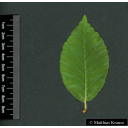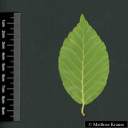Useful information about the taxon (species, subspecies, variety...)
Fagus orientalis Lipsky 1898
Fagaceae
(APG IV)Oriental beech
Akzessionnummer: LG-U-015-18762
Pflanzjahr: 2011
Patenschaftstext: Von Rainer Günther
Taxon concept: The Plant List (2014), version 1.1
Distribution: Southeast Europe, Asia Minor, Northern Caucasus, North Iran
Size: 30 - 50 (m)
Fagus orientalis Lipsky - Accepted: Fagus orientalis Lipsky bei Zander 2008; Familie: Fagaceae (Zander 2008)Fagus orientalis Lipsky - Accepted: Fagus orientalis Lipsky bei The Plant List (2014), version 1.1; Familie: Fagaceae (APG III)
- Difference to related species
- compared to closely related Fagus sylvatica occuring on drier and warmer sites and being more frost tender
- Flowers
- monoecious; male flowers in small hanging catkins, female flowers in erect inflorescences
- Flower ecology
- wind-pollinated (anemophilous)
- Life form
- tree
- Leaves
- ovate (egg-shaped), with crenate margin
- Foliage persistence
- deciduous
- Fruits
- triangular nut fruits in cupule
- Succession type
- climax species
- Natural occurrence (habitat)
- beech forests, mixed forests
- Constraints according radiation (light)
- tolerant of shade
- Usage
- wood is used for making furniture, veneer, flooring, railway tiles, paper, and as fuel
- Phytopathogenic organisms
- is affected by beech bark disease caused by infection with Phytophthora
- Bark
- smooth, silver-grey
- Altidudinal lower limit (sea level in m)
- 200
- Altitudinal higher limit (sea level in m)
- 2,200
Carey, J. H. (1992): Quercus palustris. In: Fire Effects Information System, [Online]. U.S. Department of Agriculture, Forest Service, Rocky Mountain Research Station, Fire Sciences Laboratory (Producer). See: https://www.fs.fed.us/database/feis/plants/tree/quepal/all.html; Erhardt, W., Götz, E., Bödeker, N. & Seybold, S. (2008): Der große Zander. Enzyklopädie der Pflanzennamen. Band 2. Arten und Sorten. Eugen Ulmer KG, Stuttgart (Hohenheim), 18. Aufl., 2103 S.; Gucker, C. L. (2011): Quercus macrocarpa. In: Fire Effects Information System, [Online]. U.S. Department of Agriculture, Forest Service, Rocky Mountain Research Station, Fire Sciences Laboratory (Producer). See: https://www.fs.fed.us/database/feis/plants/tree/quemac/all.html; The International Plant Names Index (2009). Published on the Internet http://www.ipni.org; Courtesy to IPNI, 2009. Exported from IPNI at date: 2009-09-22 20:17:51; The IUCN Red List of Threatened Species. www.iucnredlist.org;
Diese Webseite verwendet Google Maps, um Karten und Standorte von Pflanzen in den Hohenheimer Gärten anzuzeigen. Dadurch werden unter Umständen Daten an Google weitergeleitet, was mit einer Verarbeitung Ihrer personenbezogenen Daten verbunden sein kann. Die Datenschutzerklärung von Google finden Sie hier: Datenschutzerklärung von Google


